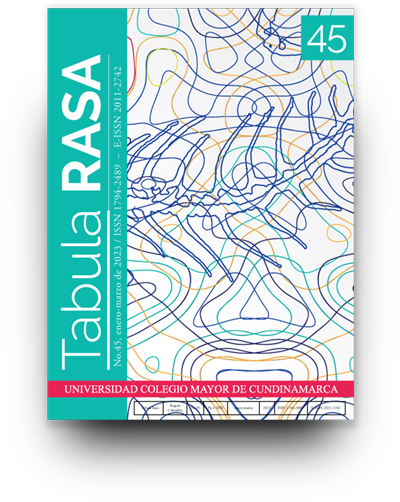Takeaways from the Teaching of Whiteness in Latin America
Aprendizajes sobre la enseñanza de la blanquedad en América Latina
Show authors biography
In this article, some findings and reflections stemmed from the investigation “Whiteness in Mexico. Towards an Understanding of Being White in Mexico to Generate Social Justice Agendas”, submitted to the University of Guadalajara; This research was carried out during the years 2020 and 2021. Part of the methodology consisted in organizing two seminars, each lasting six months, where a total of sixty-three speakers and approximately one hundred attendees participated. Based on the findings of this research, in this article I suggest that white and mixed-race people want to take part in anti-racist conversations, but they do so from binary positions which contribute to “white vs. non-white” discussions. To show this, I draw from English-speaking discussions on whiteness studies, then I mention key analyzes on whiteness in Latin America that allow us to make a conceptual distinction between the US and Latin American scholarship. Later, I will explain the topics of the seminar and will break down the implications of white-mestizo people’s voices participating in anti-racist discussions. Finally, I will delve into two central ideas, namely white-mestizo denialism and the implications of educating white bodies on anti-racism.
Article visits 312 | PDF visits 64
Downloads
- Alonso, L. (2020). Ideologías raciolingüísticas. En L. Martín Rojo & J. Pujolar (Ed.), Claves para entender el multilingüismo contemporáneo (pp. 199-228). Zaragoza: Universidad de Zaragoza.
- Banton, M. (2002). Racial theories (2d edition). Cambridge: Cambridge University Press.
- Banton, M. (1997). Ethnic and Racial Consciousness. Boston: Addison Wesley Longman.
- Camacho Buitrago, D. M. (2016). Cimarrones de la negritud: Rogerio Velásquez, Manuel Zapata Olivella y la negredumbre colombiana. En W. Mina Aragón (Ed.), Manuel Zapata Olivella. Un legado Intercultural. Perspectiva intelectual, literaria y política de un afrocolombiano cosmopolítica (pp. 89–98). Popayán: Fundación Universitaria de Popayán. Ediciones desde abajo.
- Cardoso, L. (2010). Branquitude acrítica e crítica: A supremacia racial e o branco anti- racista. Revista Latinoamericana en Ciencias Sociales, Niñez y Juventud, 8(1), 607–630.
- Diangelo, R. (2018). White Fragility. Why It´s so Hard for White Poeplo to Talk About Racism. Washington: Bacon Press.
- Du Bois, W. E. B. (2007). The souls of black folk. In The Souls of Black Folk. Oxford: Oxford University press. https://doi.org/10.4324/9781912282593
- Du Bois, W. E. B. (1996). The Philadelphia Negro. A Social Study (2d ed.). Philadelphia: University of Pennsylvania Press.
- Echeverría, B. (2007). Imágenes de la «blanquitud». En D. Lizarazo, P. Lazo & B. Echeverría (Ed.), Sociedades icónicas. Historia, ideología y cultura en la imagen (pp.15-32). México: Editorial Siglo XXI.
- Echeverría, B. (2010). Modernidad y blanquitud. México: Ediciones Era. Fanon, F. (2009). Piel negra, máscaras blancas. Madrid: Akal.
- Gleizer, D. (2014). Unwelcome Exiles. Mexico and the Jewish Refugees from Nazism, 1933–1945. Leiden: Brill.
- Martínez Casas, R., Saldívar, É., Flores, R., & Sue, C. (2014). The Different Faces of Mestizaje: Ethnicity and Race in Mexico. In Pigmentocracies. Ethnicity, Race, and Color in Latin America (pp. 36-80). Chapel Hill: The University of North Carolina Press.
- Martínez Novo, C. (1998). Racismo, amor y desarrollo comunitario. Íconos. Revista de Ciencias Sociales, 4, 98–110.
- Mattos, G., & Accioly, I. (2021). ‘Tornar-se negra, tornar-se branca’ e os riscos do ‘antirracismo de fachada’ no Brasil contemporâneo. Latin American and Caribbean Ethnic Studies, 00(00), 1–12. https://doi.org/10.1080/17442222.2021.2015950
- Moreno Figueroa, M. G. (2012). «Yo nunca he tenido la necesidad de nombrarme»: reconocimiendo el racismo y el mestizaje en México. En Racismo y otras formas de intolerancia de Norte a Sur en America Latina (pp.15-48). Juan Pablos Editor. Universidad Autónoma Metropolitana.
- Moreno Figueroa, M. G. (2010). Distributed intensities: Whiteness, mestizaje and the logicx of Mexican racism. Ethnicities, 10(3), 387–401.
- Ramos Zayas, A. (2020). Prenting Empires: Class, Whiteness, and the Moral Economy of Privilege in Latin America. Durham: Duke University Press.
- Restrepo, E. (2013). Etnización de la negridad: la invención de las «comunidades negras» como grupo étnico en Colombia. Popayán: Universidad del Cauca. Pontificia Universidad Javeriana.
- Ribeiro, D. (2020). Lugar de enunciación. Madrid: Ediciones Ambulantes.
- Sovik, L. (2004). Aqui ninguem é branco: hegemonia branca e media no Brasil. In V. Ware (Ed.), Branquidade: Identidade branca e multiculturalismo (pp.363-386). Rio de Janeiro: Garamond.
- Srivastava, S. (2006). Tears, Fears and Careers: Anti-Racism and Emotion in Social Movement Organizations. Canadian Journal of Sociology / Cahiers Canadiens de Sociologie, 31(1), 55. https://doi.org/10.2307/20058680
- Twine, F. W. (2010). A white side of black Britain. Interracial Intimacy and racial literacy. Durham: Duke University Press.
- Twine, F. W., & Gallagher, C. (2008). Introduction: The future of whiteness: A map of the “third wave.” Ethnic and Racial Studies, 31(1), 4–24. https://doi. org/10.1080/01419870701538836
- Unam (2006). Visiones de la palabra: Bolívar Echeverría. Imagen, historia y política. https://www.youtube.com/watch?v=kCqB4GxUAsE&t=729s
- Valderrama Rentería, C. A. (2016). Intelectualidad crítica afrocolombiana: la negredumbre en el pensamiento intelectual de Rogerio Velásquez Murillo. Nómadas, 45, 215-227. https://doi.org/10.30578/nomadas.n45a14
- Viveros Vigoya, M. (2015). Social Mobility, Whiteness, and Whitening in Colombia. The Journal of Latin American and Caribbean Anthropology, 20(3), 496–512.
- Yankelevich, P. (2015). Judeofobia y revolución en México. En P. Yankelevich (Ed.), Inmigración y racismo. Contribuciones a la historia de los extranjeros en México (pp.195-234). México: El Colegio de México.




